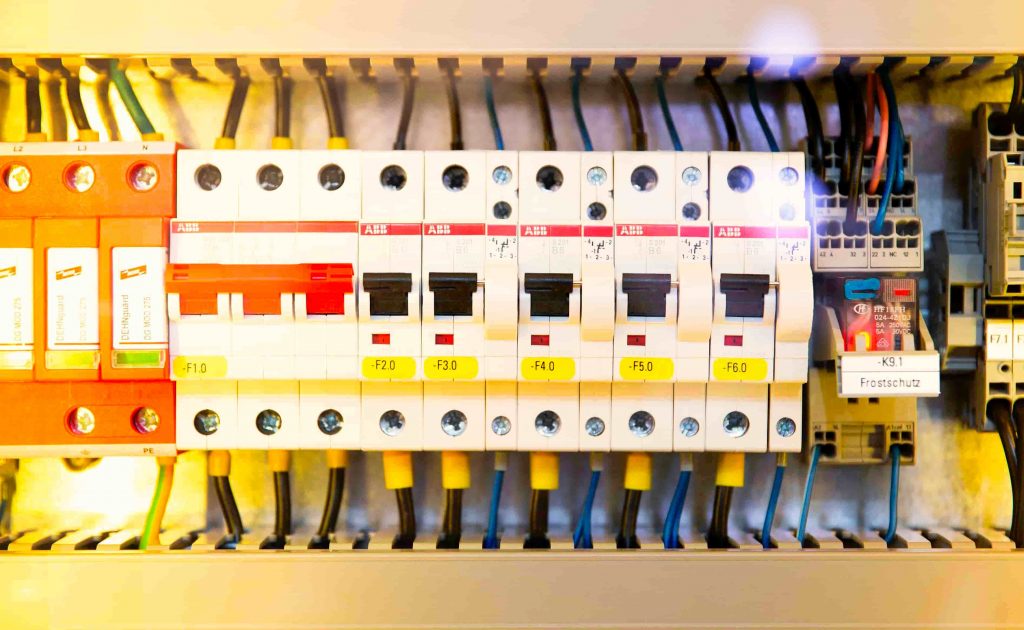All homeowners experience electrical wiring of a house and the problems associated with it from time to time. In Singapore, one of the most common electricity-related issues that you can face is circuit breaker tripping.
When the circuit breaker trips, it can shut down the electric supply to the whole house or building.
However, at other times, the circuit breaker keeps tripping continuously. It can be due to several reasons and may indicate a severe fault.
In the upcoming sections, we will describe the various causes of why circuit breaker trips, their proposed solutions, as well as tips on how such circuit breaker trips can be prevented.
Helpful read: Electrician Cost In Singapore
Causes of Circuit Breaker Tripping
In most cases, a circuit breaker trips when the electrical load is higher than the limit which the circuit breaker can handle. Circuit breakers have a limit value in the units of the amp.
When the electric load exceeds this limit, the circuit breaker trips, however, there can be other reasons why such tripping occurs. The reasons are discussed below:
Electricity Overload
This is the most common cause of electric circuit tripping. Electrical circuits have a capacity rating which is the maximum load they can handle.
When you switch on appliances whose combined electric load is higher than the capacity of the circuit breaker, it will trip. This tripping prevents the electrical system from overheating, thus, saving you from some more serious electrical issues.
During electrical works such as lighting or data point installation, be sure to ask professionals regarding the load of the appliances to reduce the chances of overloading.
Short-Circuiting
The next most common reason for circuit breaker tripping is short-circuiting. This is, however, a hazardous cause that can lead to severe problems and needs to be dealt with immediately.
A short circuit occurs when a heated wire touches a neutral wire or any other wire accidentally resulting in a large amount of electric current flowing through the circuit.
This causes excessive heating and circuit breaker trips. If the circuit breaker does not trip, it can even result in an electric fire which can be extremely dangerous and life-threatening.
This short-circuiting can occur in the electric appliances or the wiring inside your home. The source of a short circuit can thus be challenging to identify.
When with such an issue, it is best to hire a qualified electrician to look at the problem for you.
Find Qualified Electricians In Singapore
Helpful read: Causes of Outlets Sparking and What To Do About Them
Grounding Faults
Ground faults that cause the circuit breaker to trip can be categorised as short-circuiting. In this problem, a hot wire may touch the ground wire or the metal enclosure connected with the ground wires.
When they come in contact, a high amount of electric current will pass through the circuit. This current, when it exceeds the circuit’s capacity, will cause it to trip.
How To Solve The Issues of Circuit Breaker Tripping
The problems that cause the circuit breaker to trip need to be appropriately diagnosed to prevent more circuit breaker tripping and other pressing issues.
Here, we will describe some of the ways through which you can take care of the factors that are causing the circuit breaker tripping.
Fixing Electricity Overload Problem
A circuit breaker may be connected to some specific power outlets in your home. When you plug in high-power appliances in those outlets, it can exceed that circuit’s capacity causing it to trip.
The simplest solution, in this case, could be to distribute a load of your electrical appliances to different outlets which are connected with different circuits.
If you require certain appliances and devices at a particular location, which cannot be moved to some other outlet, the solution could be to replace that circuit breaker with a bigger capacity one to ensure that it does not trip with the high load of those devices.
Also, switch off devices when they are not in use to reduce the load on the circuit. Sometimes, an electricity overload problem could arise because of loose wire connections in the appliances’ plugs and power outlets.
Check to see if any connection is loose and tighten them to prevent the load from exceeding.
Find an Electrical Repairing Expert
Fixing Short-Circuiting Problems
If a circuit breaker trips when you plug in an electrical appliance, it could be because of a short circuit. Please turn off the device and take out its plug from the socket.
Examine the plug and socket for any visible signs of heating or melting. You might even smell something burning or discolouration of the plugs or sockets.
The next step would be to examine the insulation on the power outlet to see if it is damaged or cracked. This damaged insulation can cause the wires to come in contact with each other.
If the insulation on this outlet seems fine, check on all the outlets that are connected to that circuit breaker. If you are still not able to identify the source of the short-circuiting, it is a good idea to call for professional help.
Fixing Ground Faults
The process of identifying ground faults as the reason for circuit breaker tripping is the same as that of looking for short-circuiting. You could look for visible signs to check if the hot wire came in contact with the ground wire or the metal casing.
One strategy of checking if this issue was caused by an electric appliance or a fault in the wiring is to disconnect all electrical appliances and turn on the circuit breaker. If it trips again, that means that the ground fault occurred in the home wiring and not because of some electric appliances.
On the contrary, if the circuit breaker does not trip again, this means the home wiring is working correctly, and some electric appliance caused the fault. You can connect each appliance one by one to see when the circuit breaker trips.
If you are unable to identify the source of the problem, you should call a professional technician who would locate the source of the circuit breaker tripping.
How To Prevent Circuit Breaker Tripping
Once a circuit breaker trips, you can try to identify the cause of tripping and do the necessary actions to solve the problem.
However, there are specific steps that you can take to prevent a circuit breaker from tripping in the first place. These steps are listed below:
- One of the simplest things you can do is to unplug all electrical appliances when they are not in use. Just turning them off while they are still plugged in the socket will still allow electrical current to flow through them which can become a source of some problems.
- Distributing the electrical load of the appliances over various circuit breakers will prevent them from tripping from overload.
- Replacing a low-capacity circuit breaker with a bigger capacity one for those outlets that require a high electricity load will prevent it from tripping.
- Ensure that the electrical cords of appliances are not damaged.
- Make sure that the power sockets and plugs are not loose.
A circuit breaker tripping can be quite annoying, but it can point to a severe fault in the electrical system of your house. Using the guidelines described above, you can prevent circuit breaker tripping, or if it trips, you can act on these tips to solve the problem of circuit breaker tripping.
Frequently Asked Questions (FAQs)
How do you fix a breaker that keeps tripping?
To fix a breaker that keeps tripping, first turn off all appliances on the affected circuit and reset the breaker by switching it off and then back on. If the breaker continues to trip, the cause may be an overloaded circuit, a malfunctioning appliance, or faulty wiring. Inspect for damaged outlets, plugs, or wiring. If the issue persists, it’s important to consult a licensed electrician for a thorough diagnosis and repair, as continued tripping may indicate a more serious electrical problem or the need for a dedicated circuit for high-power appliances.
What is the main cause of breaker tripping?
The main causes of a circuit breaker tripping are typically overloading, short circuits, and ground faults. Overloading occurs when too many devices are plugged into a single circuit, causing the current to exceed the breaker’s capacity. Short circuits happen when a hot wire touches a neutral wire, leading to excessive current flow that can overheat the circuit. Ground faults occur when a live wire touches the ground or metal parts of the circuit, causing an unsafe surge of electricity. Identifying the cause is key to fixing the issue safely.
How do I find what is tripping my circuit breaker?
To find what is tripping your circuit breaker, start by unplugging all devices on the affected circuit and resetting the breaker. Once the breaker is reset, plug in one appliance at a time and turn it on. If the breaker trips after plugging in a specific appliance, that appliance is likely the cause. If the breaker continues to trip with no devices plugged in, the issue may lie with the wiring, which should be inspected and repaired by a licensed electrician.
Should I be worried if a circuit breaker is tripped?
While a single tripped circuit breaker may not be cause for immediate alarm, it’s important to investigate the cause as it could signal an underlying issue, such as an overload, short circuit, or wiring problem. If the breaker trips repeatedly, it’s crucial to stop using the affected circuit and call an electrician to diagnose and resolve the issue. Prompt action is essential to prevent potential safety hazards like electrical fires.
How to fix MCB tripping?
To fix an MCB (Miniature Circuit Breaker) tripping, start by unplugging all devices connected to the circuit to check for overloading. If the MCB still trips, the issue may be a short circuit or ground fault. Inspect wiring and outlets for damage. If the problem persists, it’s best to consult a licensed electrician to safely diagnose and resolve any underlying electrical issues.
How many times can a breaker trip?
A breaker can trip multiple times, but frequent tripping usually indicates an underlying issue, such as an overload or faulty wiring. While most circuit breakers are designed for 10,000 to 20,000 mechanical operations, excessive trips can cause wear and tear, reducing their lifespan. If a breaker trips repeatedly, it’s important to identify and address the root cause immediately, as prolonged tripping can lead to permanent damage or safety hazards. In such cases, it may be necessary to replace the breaker.
Other Home Improvement Areas
You can check out the cost of hiring professionals for other aspects if your home improvement project. Some of the usual cost guides can be found below:
We’re here to improve your home
Speak to hundreds of reliable pros, view their gallery, inspirations, and know the best prices with our resources.
Have full control over your home improvement projects with Homees.





